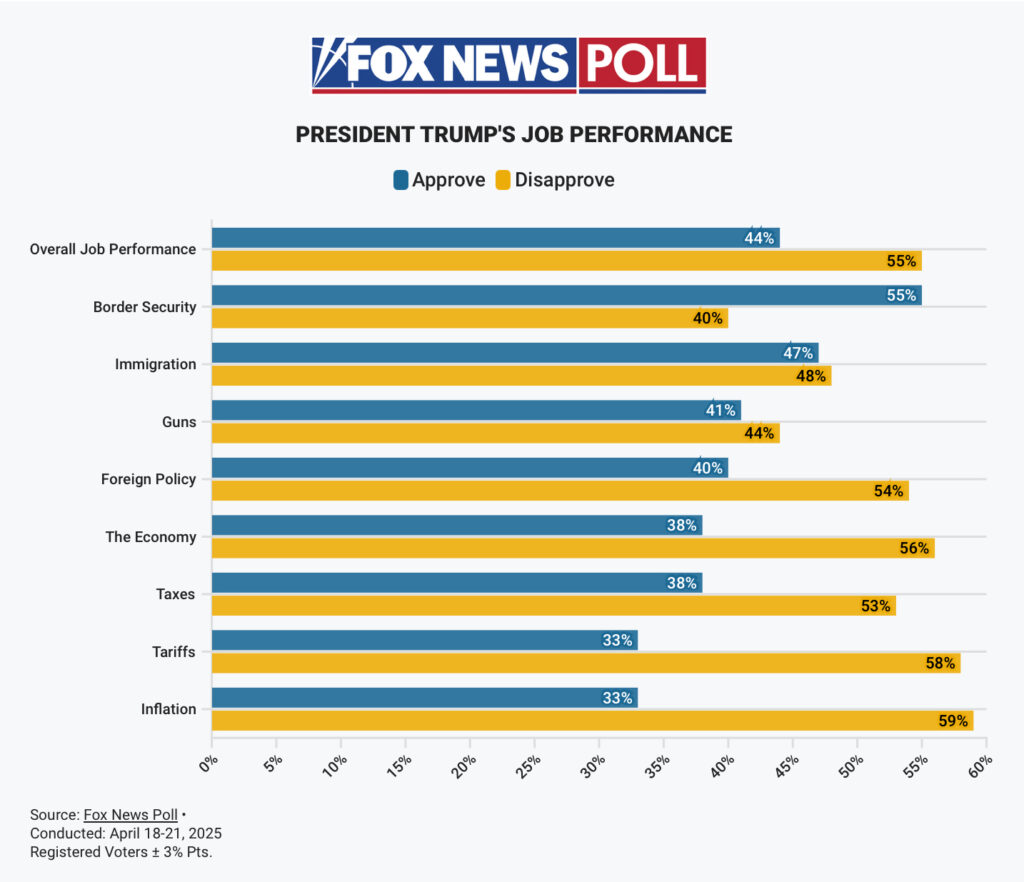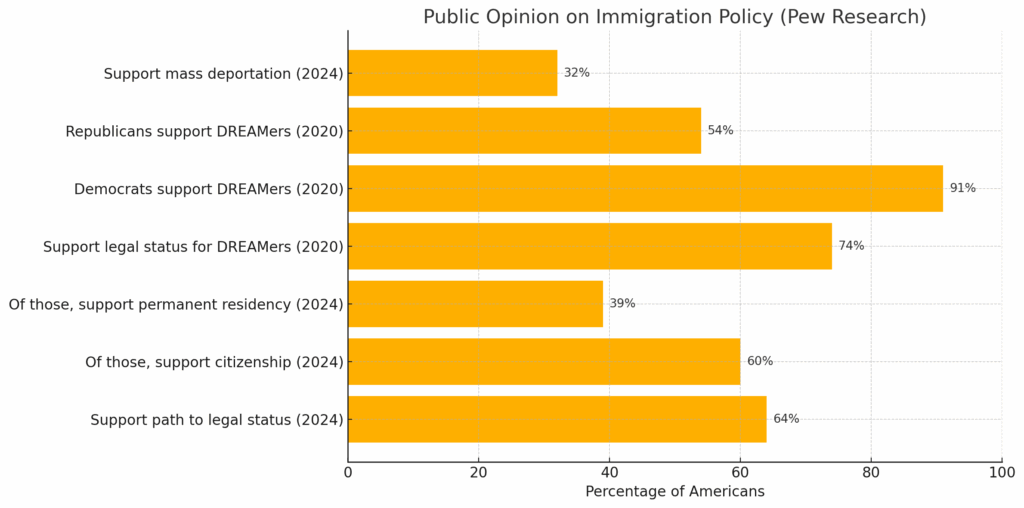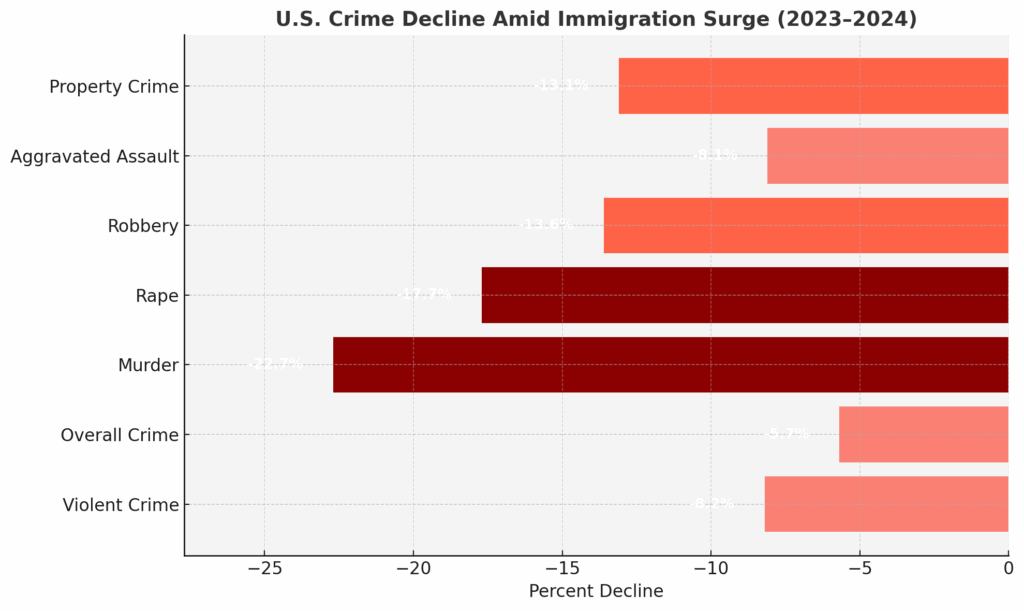The current state of U.S. immigration policy reflects a troubling and deepening polarization. Rather than engaging in constructive debate to reform a broken system, President Trump and some political leaders in the Republican Party have resorted to extreme and punitive measures that disregard both economic logic and human dignity. The resurgence of anti-immigrant rhetoric, proposals for mass deportations, and policies rooted in fear—rather than fact—pose a grave threat not only to immigrant communities but to the moral fabric of our nation. One of the most alarming examples was the Trump administration’s controversial deportation of migrants to countries like El Salvador, including individuals with pending asylum claims and others facing credible threats to their lives. These actions, and the push to revive and expand them, demand urgent scrutiny and an honest reckoning with what kind of country we choose to be.

Public opinion on immigration is far less divided than Congress would have you believe. Importantly, the latest poll from FOX News reveals that 48% of Americans disapprove of President Trump’s handling of immigration, while only 47% approve. This means President Trump, and the country will gain much, if he embraced immigration reform rather than his current path of massive deportations and demonization of immigrants. A Pew Research Center survey from August 2024 found that 64% of Americans believe undocumented immigrants should have a way to stay in the country legally if certain requirements are met—most favoring a path to citizenship. Among those who support legal status, 60% favor allowing these immigrants to apply for citizenship, while another 39% support permanent residency. Support is even stronger for immigrants brought to the U.S. as children: a 2020 Pew poll showed 74% of Americans—91% of Democrats and 54% of Republicans—favor granting legal status to these so-called “DREAMers.” Meanwhile, support for mass deportations remains limited: only 32% of Americans support deporting all undocumented immigrants, with the vast majority favoring deportation only in cases involving violent crime. These findings underscore that Americans want a balanced and humane approach—not blanket enforcement.


Moreover, the false narrative that the recent surge in immigration is an economic burden does not stand up to scrutiny. According to the Congressional Budget Office (CBO), the immigration surge between 2021 and 2024 is projected to reduce federal deficits by $900 billion over the 2024–2034 period. Federal revenues are expected to increase by $1.2 trillion—primarily through income and payroll taxes paid by immigrants—while mandatory spending and interest costs are projected to rise by only $300 billion. Economically, the CBO forecasts an $8.9 trillion boost in nominal GDP over the decade, driven by a larger labor force, increased productivity, and greater personal consumption. These findings are reinforced by the Federal Reserve Bank of Dallas, which projects immigration will add 5.2 million workers by 2033 and contribute $1.2 trillion in federal tax revenue, with minimal impact on inflation. Far from harming the U.S. economy, this migration surge helps sustain growth, expand the workforce, and directly supports programs like Social Security.
This demographic contribution is particularly crucial as the nation grapples with an aging population, according to research from the prestigious PEW Center. Immigrants and their descendants are projected to account for nearly 90% of U.S. population growth through 2065, helping to maintain a balanced age structure and avert economic stagnation. States such as Iowa, North Carolina, Colorado, and Washington have benefited notably, with immigrant labor filling workforce gaps. Research from the American Immigration Council also confirms in states facing population decline and aging challenges—like Pennsylvania, Massachusetts, and New York—immigration has helped stabilize the labor force and prevent sharper demographic erosion. In Pennsylvania, leaders have openly acknowledged the state’s dependence on attracting immigrants to counteract the effects of aging and outmigration. These trends are not just economic—they help safeguard the long-term viability of Social Security, Medicare and Medicaid by expanding the pool of working-age contributors supporting an increasing number of retirees.
Undocumented immigrants, often overlooked in fiscal discussions, make substantial contributions to public finances, according to data collected by researchers from the IRS. In 2022, they paid nearly $97 billion in federal, state, and local taxes. This includes approximately $59.4 billion to the federal government—encompassing income, Social Security, Medicare, and unemployment insurance taxes—and $37.3 billion to state and local governments through sales, property, and income taxes. Notably, undocumented immigrants pay an average effective state and local tax rate of 8.9%, which is higher than the 7.2% rate paid by the top 1% of earners. Despite these substantial payments, undocumented immigrants are ineligible for most federal benefits, underscoring their net positive impact on public finances.
Similarly, Temporary Protected Status (TPS) holders significantly bolster public revenues, according to research from the American Immigration Council based on data from the IRS and States sources. In 2021, households led by TPS recipients paid approximately $2.2 billion in taxes—comprising $1.3 billion in federal taxes and $966.5 million in state and local taxes. These contributions support essential programs like Social Security and Medicare, despite TPS holders’ limited access to such benefits. With an employment rate exceeding 94%, TPS holders also possess over $8 billion in spending power, stimulating local economies across the nation.
Now let’s address the elephant in the room: the narrative linking immigration to crime. Despite persistent political rhetoric suggesting that increased immigration leads to greater criminality, the data tells a very different story. Between 2019 and 2023, the United States experienced a significant surge in immigration, including a rise in encounters at the southern border. Yet during that same period, crime rates—especially violent crime—declined across the country. According to FBI data, the national violent crime rate dropped by 8.2% in 2023 alone, while overall reported crime declined by 5.7%. Property crime remained stable or declined in many areas.
Decades of research confirm what these recent trends reinforce: there is no positive correlation between immigration and crime. In fact, immigrants are statistically less likely to commit crimes than native-born citizens. The narrative that immigration fuels criminality is not only inaccurate—it undermines the case for a rational, evidence-based approach to immigration reform.
And the downward trend continued. Between 2023 and 2024, according to the FBI’s Quarterly Uniform Crime Report (covering January through June 2024), violent crime decreased by another 10.3% compared to the same period in the previous year. Key categories saw even sharper declines: murder dropped by 22.7%, rape by 17.7%, robbery by 13.6%, and aggravated assault by 8.1%. Property crime also declined by 13.1%. These results further dismantle the myth that rising immigration equals rising crime—and reinforce the need for policy guided by data, not fear.

If the Trump “Gold Card” plan for affluent migrants is moving forward, there’s no reason we can’t enact a reasonable program that imposes a fine and offers a pathway to permanent residency for the vast majority of hardworking, entrepreneurial, and law-abiding families among the 13 million undocumented immigrants who have contributed to our nation for decades.
This approach is both moral and just. We acknowledge that these individuals are vital members of our communities. By imposing a fine ranging from $5,000 to $10,000 per migrant, the U.S. government could generate between $65 billion and $130 billion in revenue. This influx could significantly alleviate the national fiscal deficit by 5% to 10% this year.
Moreover, this solution is far more economically advantageous than the proposed $86 billion mass deportation spending plan by Tom Homan, the “Border Czar,” which would burden the economies and labor markets where these undocumented migrants have already integrated. These individuals contribute over $60 billion in federal taxes and $37 billion in state and local taxes each year.
Additionally, any serious immigration reform bill should incorporate provisions to grant direct citizenship, without penalty, to all DACA recipients—who have lived under uncertainty for far too long despite being deeply embedded in the American economy and society.
For decades, the U.S. has stood paralyzed on immigration reform—talking tough, doing little, and choosing political theater over real solutions. This paralysis isn’t due to a lack of ideas or public support. It’s rooted in cowardice: the refusal to legislate comprehensive reform that would address the needs of our economy, the humanity of millions of immigrants, and the security of our borders with the same stroke of the pen.
What we need is courage. The courage to legislate. The courage to tell the truth about immigrants’ contributions. The courage to build a system that works for all Americans, not just political operatives feeding on fear.
Instead of slashing Medicaid or charging against Social Security, Congress should embrace immigration reform as a realistic, moral, and fiscally responsible solution. The time for cowardice is over. It’s time for courage to deliver the reform this country needs—and the dignity millions deserve.
